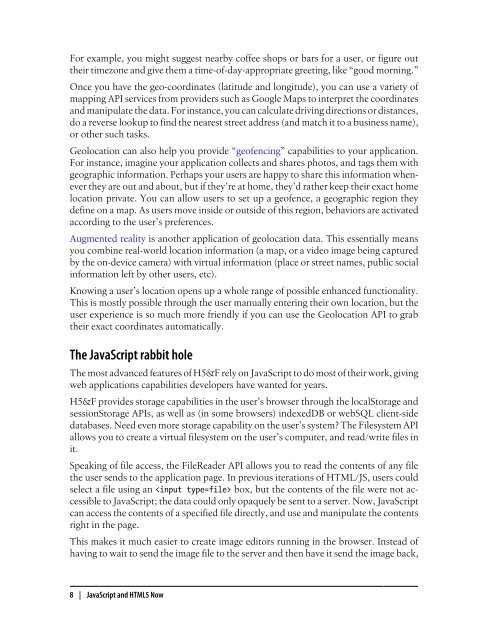JavaScript and HTML5 Now Kyle Simpson
JavaScript and HTML5 Now Kyle Simpson
JavaScript and HTML5 Now Kyle Simpson
Create successful ePaper yourself
Turn your PDF publications into a flip-book with our unique Google optimized e-Paper software.
For example, you might suggest nearby coffee shops or bars for a user, or figure out<br />
their timezone <strong>and</strong> give them a time-of-day-appropriate greeting, like “good morning.”<br />
Once you have the geo-coordinates (latitude <strong>and</strong> longitude), you can use a variety of<br />
mapping API services from providers such as Google Maps to interpret the coordinates<br />
<strong>and</strong> manipulate the data. For instance, you can calculate driving directions or distances,<br />
do a reverse lookup to find the nearest street address (<strong>and</strong> match it to a business name),<br />
or other such tasks.<br />
Geolocation can also help you provide “geofencing” capabilities to your application.<br />
For instance, imagine your application collects <strong>and</strong> shares photos, <strong>and</strong> tags them with<br />
geographic information. Perhaps your users are happy to share this information whenever<br />
they are out <strong>and</strong> about, but if they’re at home, they’d rather keep their exact home<br />
location private. You can allow users to set up a geofence, a geographic region they<br />
define on a map. As users move inside or outside of this region, behaviors are activated<br />
according to the user’s preferences.<br />
Augmented reality is another application of geolocation data. This essentially means<br />
you combine real-world location information (a map, or a video image being captured<br />
by the on-device camera) with virtual information (place or street names, public social<br />
information left by other users, etc).<br />
Knowing a user’s location opens up a whole range of possible enhanced functionality.<br />
This is mostly possible through the user manually entering their own location, but the<br />
user experience is so much more friendly if you can use the Geolocation API to grab<br />
their exact coordinates automatically.<br />
The <strong>JavaScript</strong> rabbit hole<br />
The most advanced features of H5&F rely on <strong>JavaScript</strong> to do most of their work, giving<br />
web applications capabilities developers have wanted for years.<br />
H5&F provides storage capabilities in the user’s browser through the localStorage <strong>and</strong><br />
sessionStorage APIs, as well as (in some browsers) indexedDB or webSQL client-side<br />
databases. Need even more storage capability on the user’s system? The Filesystem API<br />
allows you to create a virtual filesystem on the user’s computer, <strong>and</strong> read/write files in<br />
it.<br />
Speaking of file access, the FileReader API allows you to read the contents of any file<br />
the user sends to the application page. In previous iterations of HTML/JS, users could<br />
select a file using an box, but the contents of the file were not accessible<br />
to <strong>JavaScript</strong>; the data could only opaquely be sent to a server. <strong>Now</strong>, <strong>JavaScript</strong><br />
can access the contents of a specified file directly, <strong>and</strong> use <strong>and</strong> manipulate the contents<br />
right in the page.<br />
This makes it much easier to create image editors running in the browser. Instead of<br />
having to wait to send the image file to the server <strong>and</strong> then have it send the image back,<br />
8 | <strong>JavaScript</strong> <strong>and</strong> <strong>HTML5</strong> <strong>Now</strong>


